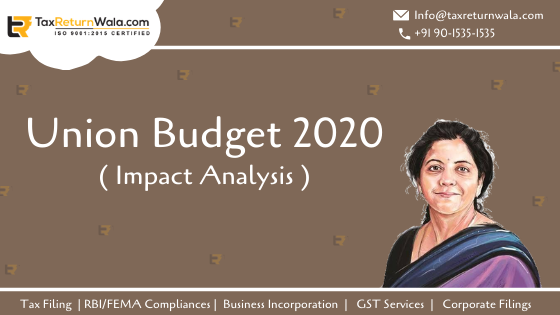Union Budget 2020
Finance Minister Smt. Nirmala Sitharaman (FM) has presented her second and the Modi government’s seventh consecutive Union Budget 2020 in Parliament today. The Indian economy has in recent days witnessed slowing trade, rising protectionism accompanied with the increasing unemployment
FM states budget based on three broad themes:
- Aspirational India covers agriculture, irrigation, rural development, wellness, sanitation, education and skills development in this area. FM has provided funds for various facilities related to Swatch Bharat Abhiyan, water harvesting, new education policy (that is yet to be announced soon), Urban local bodies to be providing internships and apprenticeships to fresher engineers, higher quality education through online mode (by leading 100 institutes of India), setting up of new medical colleges attached with every district medical hospital under PPP mode, aim to get started 100 new airports by 2024 and most importantly initiation of consolidated steps in order to double the income of farmers by 2022
- Economic development perspective which is inclined to cover the Industry and Commerce of the Country by establishing of latest textile technology, set up of investment clearance cell for entrepreneurs, encouragement of manufacturing in Mobiles and electronic products, specialized NIRVIK scheme for exporters with less premium on higher insurance. In railways more Tejas trains will be started to connect the tourist towns, solar power panels on the side of rail tracks,150 passengers train will be started and more to come on high speed and the bullet train. Setting up of data center parks for private sector, new prepaid smart meters for electricity for customer to choose rate and supplier, plan to have clean/ clear air, introduction of a taxpayer charter, gram panchayat/post office/police stations to be digitalized in coming future, special allocation to reserved and backward classes/senior citizen and differently-abled, special courses/ training to be initiated for those seeking employment abroad, new 150 higher education institutions to start apprenticeship embedded courses, IND-SAT to be introduced understudy in India program, new logistics policy to be launched soon, expansion of gas grid, proposal to establish Indian Institute of Heritage and Conservation, setting up of Tribal museum, Maritime museum to be set up.
- Caring society India shall focus to include good governance by clean India, corruption-free India, amendment to be proposed in the companies act 2013 for the criminal liability on civil acts, speedy end of disputes by Robust mechanism, IDBI shall come forward to sell its shares to public for restructuring, depositor insurance cover by banks/ financial institutes to be increased from 1lakh to 5 lakh, Initial Public Offer of LIC proposed to be launched, initiative to include 20,000 hospitals under Jan Arogya Yojna, expansion of Jan Aushadhi Kendra to all districts by 2024, focus of greywater and waste management, implementation of task force to improve nutrition levels, setting up of Disaster Resilient Infrastructure.
Direct Tax Changes at a glance for A.Y 2021-22:
Individual Income tax slab for A.Y 2021-22 (new tax regime)
(without any Deduction and Exemptions being claimed by the assessee)
| Income during the FY 2020-21 |
TAX Rate |
| Upto 2.5 lakhs | Nil |
| 2.5 to 5 lakhs | 5% |
| 5 to 7.5 lakhs | 10% |
| 7.5 to 10 lakhs | 15% |
| 10 to 12.5 lakhs | 20% |
| 12.5 to 15 lakhs | 25% |
| Above 15 lakhs | 30% |
Surcharge and cess shall be continued to be levied at the existing rates.
The new tax regime is optional for the taxpayers, one can opt for the old excising regime if at all the assessee wishes to claim for deductions and exemptions.
(Option to choose New Slabs without Deduction Claim or Old Slabs With Deductions, clarity has been provided that Individuals opting for taxation under new rates will not be entitled to exemption/deductions including under chapter VI-A, LTC, housing rent allowance, deduction for entertainment allowance, professional tax, and interest on self-occupied/vacant property.)
Additional insights to be derived from the budget in relation to Direct Tax
- Now the companies do not have to pay Dividend Distribution Tax it shall now be calculated in individual income
- Those earning up to 5 lakhs shall not pay any tax either in the old regime or in the new regime
- The concessional tax rate for electricity companies are now at 15%
- The turnover threshold for a tax audit of MSMEs to be increased from Rs 1 crore to Rs 5 crore, but only for those which carry out only less than 5% of their business in cash
- Additional deduction up to one lakh fifty thousand rupees is allowed for interest paid on loans sanctioned up to 31st March 2020 for purchase of an affordable house now this benefit has been increased for all loans that shall be sanctioned till 31st March 2021
- Vivad se Vishvas scheme to be brought in for reducing tax litigation for direct tax cases
- Instantly PAN allotment system based on Aadhar card
- Tax on Cooperative societies proposed to be reduced to 22 percent as against 30 percent at present plus 10% surcharge plus 4% cess.
- Income Tax Act to be amended to allow faceless appeals against tax orders on lines of faceless assessment
- In order to extend the benefit of tax holiday to larger start-ups, it is proposed to increase the turnover for claiming tax holiday from Rs. 25 crores to Rs. 100 crores. For start-ups that may not have profit in initial years for availing tax benefit, it is proposed to extend the period of eligibility for a claim of 100% deduction from the 7 years to 10 years.
- Proposed to reduce the rate for TDS in case of fees for technical services (other than professional services) to two percent from ten percent
- proposed to reduce the time of stay in India from 182 days to 120 days for an Indian citizen or person of Indian origin to become Resident in India.
- It is proposed to relax the provision of “resident but not ordinarily resident” which shall now mean that a resident who has been non-resident in seven out of ten previous years would be resident but not ordinarily resident which impliedly means that an Indian citizen who is not liable to tax anywhere would be deemed to be resident in India
Indirect Tax Changes at a glance for A.Y 2021-22:
- As a continued effort to simplify GST, there shall be provided a provision for Simplified return, It will make return filing simple with features like SMS based filing for nil return, return pre-filling.
- Tax Refund process has been simplified and fully system automated.
- Electronic invoicing feature to be implemented soon wherein critical information shall be captured electronically in a centralized system
- Dynamic QR-code is proposed for consumer invoices. GST parameters are proposed to be captured once the payment for purchases is made via QR-code
- If invoice and input tax credit does not match with return and not matched data is above 10% then those returns are identified and perused
- Stringent check for import under the Free Trade Agreement
- Cheap and low-quality imports are to be put at stake in all those sectors wherein those items which are being produced by Indian MSMEs with better quality
- The imposition of a nominal health cess, by way of a duty of customs, on the imports of medical equipment the proceeds of which be used for creating an infrastructure for health services
- Customs duty rates are proposed to be revised on electric vehicles
- Basic customs duty reduced to 5% on the newsprint and lightweight coated paper
- Anti-dumping duty on certain specified chemicals of routine industry usage is being abolished
- Rise in excise duty on cigarette and tobacco products
Need more insights on the budget?
Please feel free to write to us at info@taxreturnwala.com


